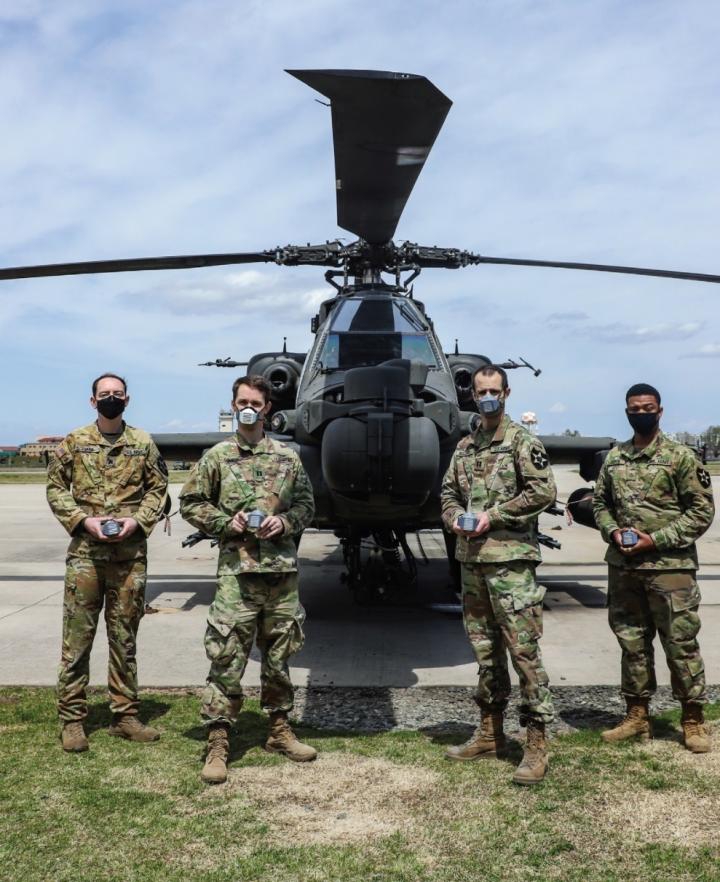
Credit: (U.S Army photo by KCpl. Hanmin Yun. 2ID/RUCD Public Affairs)
ARLINGTON, Va.–The coronavirus pandemic has caused a global shortage of surgical face masks and other personal protective equipment (PPE), including for warfighters stationed at U.S. Forces Korea.
To address this, the Office of Naval Research (ONR) Global TechSolutions is working with multiple partners to develop prototypes of 3D-printable (also called additive manufactured) masks for use at Camp Humphreys in South Korea.
The prototypes are designed for warfighters needing masks for use with tactical gear like combat helmets and protective visors–security personnel, for example. Printed from medical-grade plastic, with a replaceable filter, the masks form a tighter seal around the nose and mouth. This forces breathed air through the filter only, instead of through gaps between the fabric and skin, reducing infection risk.
“This shows the power of effective collaboration in meeting an urgent need,” said TechSolutions Director Jason Payne. “It enables us to do whatever we can to slow the spread of coronavirus and keep it contained to the best of our ability–so it doesn’t prevent our warfighters from performing their missions.”
TechSolutions is ONR Global’s rapid-response science and technology program that develops prototype technologies to address problems voiced by Sailors and Marines, within approximately 12 months. The PPE collaboration involves the U.S. Army’s Combat Capabilities Development Command, U.S. Forces Korea and the Naval Undersea Warfare Center (NUWC) Division Keyport.
The project stems from efforts by Mark Buffum, the ONR Global science advisor assigned to U.S. Forces Korea. When the coronavirus pandemic began, South Korea emerged as a hotspot, resulting in PPE shortages throughout that country. Other regions of Asia saw similar shortages, including multiple suppliers to U.S. Forces Korea.
Buffum researched creative ways in which command personnel responded to PPE shortages. He coordinated with the Army’s Combat Capabilities Development Command to leverage a donation of bulk filter material from a Pennsylvania-based manufacturing supplier–as well as a mask design from an Army officer stationed at U.S. Forces Korea–to 3D-print masks. Unfortunately, the “hobby-grade” machine available at Camp Humphreys could only produce seven masks daily.
Seeking to expand this capability, Buffum contacted TechSolutions and partnered with Payne’s team and NUWC Keyport–which has industrial-grade 3D printers able to manufacture hundreds of masks a day.
TechSolutions agreed to sponsor a project consisting of multiple products:
- –Several 3D-printed prototypes for evaluation
–500 3D-printed masks comprising all prototype styles
–Resin molds of the prototypes. Creating masks from resin, instead of medical-grade plastic, enables hobby-grade 3D printers to produce 10 times as many masks each day.
–Technical data packages with instructions for 3D-printing or resin pouring, as well as maintaining mask designs
U.S. Forces Korea and the Army’s Combat Capabilities Development Command are evaluating the prototype masks. Once they decide on a design, they’ll work with NUWC Keyport to 3D-print large quantities of masks.
“This is a good test of how we can respond to the needs of the fleet in an emergency,” said Ross Wilhelm, principal technologist for NUWC Keyport’s Maintenance, Engineering and Industrial Operations Department. “How many masks can we produce and how fast? We hope this serves as a model for Department of Defense commands worldwide.”
In addition to tactical applications, Buffum hopes to see versions of the masks made for medical personnel and first responders to use during the coronavirus pandemic as well as future health crises.
“These masks can play a key role in strengthening our medical infrastructure of preparedness,” he said. “That way, people won’t be scrambling for supplies at the beginning of another pandemic.”
###
Media Contact
David Smalley
[email protected]
Original Source
https:/




